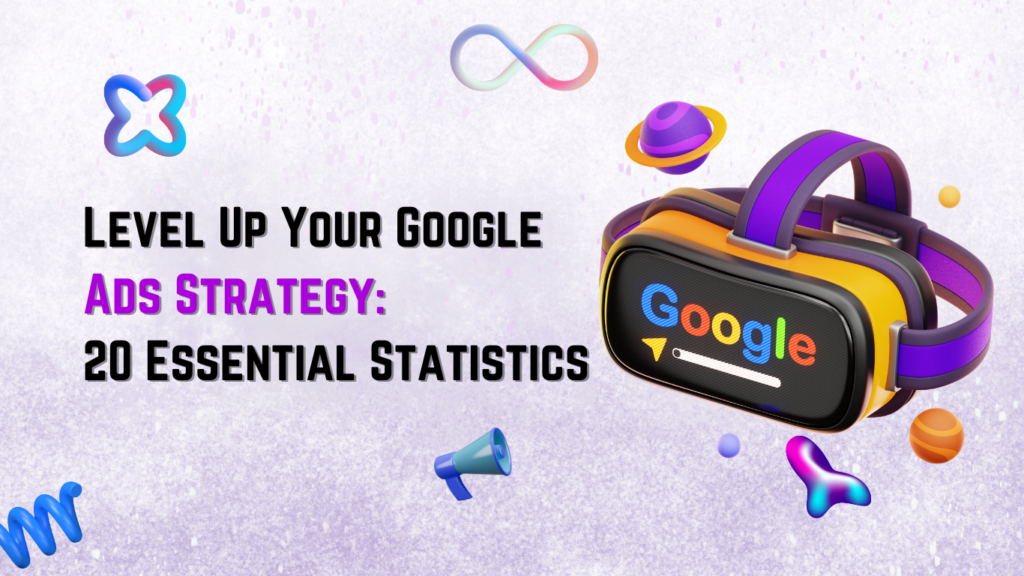
Knowing how to use Google Ads effectively can revolutionize your company in the rapidly evolving field of digital marketing. To optimize your Google Ads approach and maximize your investment, let’s explore 20 key statistics:
1. Ad Spending Growth: A Deep Dive
The digital advertising landscape is evolving rapidly, with businesses increasingly investing in online platforms to reach their target audiences. One key metric that highlights this trend is the Compound Annual Growth Rate (CAGR) of ad spending. Between 2024 and 2028, ad spending is projected to grow at a steady rate of 8.01% annually. This growth underscores the expanding role of digital advertising in modern marketing strategies.
What is CAGR?
CAGR, or Compound Annual Growth Rate, is a useful measure that describes the rate of return required for an investment to grow from its beginning balance to its ending balance, assuming profits are reinvested at the end of each period. In the context of ad spending, an 8.01% CAGR indicates a consistent year-over-year increase in investment.
Factors Driving Growth
Several factors contribute to the projected growth in ad spending:
- Digital Transformation: Businesses across all sectors are embracing digital transformation, leading to increased investments in digital advertising to reach a tech-savvy audience.
- Shift from Traditional to Digital Media: Companies are reallocating budgets from traditional media (like TV and print) to digital platforms, which offer better targeting, tracking, and engagement metrics.
- Rise of E-commerce: The growth of online shopping has propelled the need for digital advertising to attract and convert online shoppers.
- Advancements in Technology: Innovations in AI, machine learning, and big data analytics enable more effective and personalized advertising campaigns.
- Mobile Advertising: With the increasing use of smartphones, mobile advertising has become a significant component of digital ad spending.
2. Market Share: Google Ads Dominates the PPC Landscape
In the realm of pay-per-click (PPC) advertising, Google Ads continues to assert its dominance with a substantial market share of 28% globally. This impressive figure underscores Google Ads’ pivotal role and influence in the digital advertising ecosystem.
Google Ads’ commanding 28% share in the global PPC advertising space is a testament to its effectiveness, innovation, and adaptability. By offering diverse ad solutions, advanced targeting, and leveraging cutting-edge technologies, Google Ads remains an essential tool for businesses looking to maximize their online presence and achieve their marketing goals. Understanding and utilizing the full potential of Google Ads can lead to significant competitive advantages and improved ROI for advertisers.
3. Click Rates: The Importance of Prime Positioning in Paid Search Ads
A crucial indicator of the success of ad placement in the area of digital advertising, especially in pay-per-click (PPC) campaigns, is click-through rates (CTR). According to a startling statistic, the top three sponsored advertisements receive 46% of all clicks on search engine results pages (SERPs). This emphasizes how important prime positioning is to PPC advertising performance.
By leveraging strategies such as bid optimization, improving ad quality, creating compelling ad copy, and utilizing ad extensions, businesses can achieve higher ad placements and drive more traffic to their websites. Understanding and capitalizing on the significance of top positions can lead to increased visibility, credibility, and ultimately, better ROI for your digital advertising efforts.
4. Revenue Boom: Google’s Ad Revenue Soars in Q3 2024
Google’s impressive ad revenue of $65.85 billion in Q3 2024, marking a 10% year-over-year increase, underscores the company’s dominance in the digital advertising landscape.
The growth is driven by a combination of increased ad spend, diverse ad offerings, technological innovations, and a strong focus on mobile and e-commerce. As Google continues to invest in cutting-edge technologies and expand its global reach, it is well-positioned to maintain its leadership and drive further growth in the digital advertising industry.
5. Search Ads Preference: Why 70% of Companies Trust and Prefer Search Ads
The preference for search ads among 70% of companies reflects their trust in this advertising method to deliver measurable, cost-effective, and high-impact results.
Search ads’ ability to capture user intent, provide precise targeting, and offer flexibility in budgeting makes them a powerful tool in digital marketing strategies. As businesses continue to navigate the competitive digital landscape, search ads will remain a cornerstone of effective online advertising efforts.
6. Smart Bidding Efficiency: Streamlining Google Ads Campaigns
Google Ads Smart Bidding offers a powerful solution for advertisers looking to save time and improve campaign performance. By leveraging machine learning and real-time data, Smart Bidding optimizes bids for maximum conversions and ROI. Its ability to handle complex bidding strategies and scale efficiently makes it a preferred choice for many companies. Understanding and implementing Smart Bidding can significantly enhance your Google Ads campaigns, delivering better results with less manual effort.
7. Lead Generation: Leveraging Google Ads to Attract Potential Customers
Google Ads has become known as a powerful lead-generation tool that helps companies draw in quality leads with its appealing ad layouts, targeted advertising, and quantitative results.
Businesses may optimize the effectiveness of their lead generation operations by putting best practices including retargeting tactics, landing page enhancements, ad copy optimization, and keyword research into practice.
Using Google Ads to generate leads is an affordable, adaptable, and scalable way to accomplish marketing goals and propel company expansion.
8. CTR Enhancement: Strategies for Improving Click-Through Rates
In Google Ads campaigns, optimizing headlines, ad copy, and keywords are crucial tactics for raising click-through rates (CTR). Businesses may improve their ad performance and increase interaction by carrying out in-depth keyword research, writing attention-grabbing headlines, and designing ad language that is both captivating and relevant. CTR and campaign success will steadily increase if these components are tested and improved regularly using performance data.
9. Responsive Search Ads: Boosting CTR Effectively
Responsive Search Ads (RSAs) are a powerful ad format in Google Ads that significantly enhance click-through rates by dynamically adapting ad copy to match user intent. By leveraging machine learning to test and optimize various combinations of headlines and descriptions, RSAs ensure high relevance and engagement. Implementing best practices such as providing diverse headlines, focusing on unique selling points, using strong CTAs, and utilizing ad extensions can further maximize the efficacy of RSAs. As businesses continue to seek ways to improve ad performance, RSAs offer a flexible, efficient, and effective solution to boost CTR and achieve marketing goals.
10. Median Impressions in Google Ads: B2B vs. B2C
Impression counts are a key indicator of how frequently a user sees an advertisement in the world of digital advertising. Advertisers use impressions to determine the reach and visibility of their advertising. Knowing the average impression performance is crucial for companies using Google Ads. B2C (business-to-consumer) enterprises typically experience roughly 22.62K impressions, whereas B2B (business-to-business) companies typically see a median of 31.09K impressions. The target audience, ad placement, and marketing tactics are some of the variables that affect this discrepancy.
11. B2B vs. B2C
In the realm of digital advertising, clicks are a fundamental metric that measures user engagement. However, the way B2B and B2C companies approach and interpret click-through rates (CTRs) can vary significantly.
B2B companies often find themselves with higher click-through rates compared to their B2C counterparts.
While B2B companies may boast higher click-through rates, it’s important to remember that quality over quantity is paramount. A high click-through rate is meaningless if it doesn’t translate into meaningful conversions and revenue.
12. Cost Management in Google Ads
Effective cost management is a cornerstone of any successful Google Ads campaign. By careful budgeting, monitoring, and adjusting your bids, you can optimize your ad spend.
By effectively implementing these strategies, you can control your Google Ads costs, improve campaign performance, and achieve your marketing objectives. Remember, continuous monitoring and optimization are crucial to staying ahead of the competition maximizing your ROI, and maximizing your return on investment (ROI).
13. Google’s Mobile Dominance: A Third of Mobile Ad Spend
A staggering 33% of all mobile advertising dollars are allocated to Google Ads. This substantial figure highlights Google’s powerful position in the mobile advertising landscape.
As mobile usage continues to soar, Google Ads remains a crucial platform for businesses to connect with their target audience and drive conversions.
By understanding the significance of this statistic, marketers can leverage Google’s powerful tools to achieve their mobile advertising goals.
14. Google’s Iron Grip on the UK Search Market
Google’s dominance in the UK search market is undeniable. With a commanding 81.95% market share, it’s the go-to search engine for the vast majority of UK internet users.
This overwhelming market share underscores the importance of Google Ads for businesses targeting the UK market. By leveraging Google’s powerful advertising platform, businesses can reach their target audience effectively and drive conversions.
15. A Click Away: High Engagement with Google Ads
A remarkable 63% of internet users have clicked on a Google ad at some point. This high engagement rate underscores the effectiveness of Google Ads as a powerful tool for reaching and converting target audiences.
16. Google’s Dominance in the US Ad Market
In 2023, Google’s advertising revenue in the United States reached a staggering $224.47 billion. This substantial figure underscores Google’s dominant position in the US digital advertising landscape.
This substantial ad revenue demonstrates the power of Google Ads and its ability to help businesses of all sizes achieve their marketing goals in the United States.
17. Google’s Ad-Driven Revenue Model
A staggering 77% of Google’s total income in 2023 was derived from advertising. This demonstrates the immense power and profitability of Google’s advertising platform.
Google has created a very successful advertising business that supports its expansion and innovation by utilizing its large user base, sophisticated targeting tools, and variety of ad forms.
18. Google Shopping Ads
A significant portion of retail search ad spending in the US is dominated by Google Shopping Ads. A whopping 76.4% of this spending is allocated to these ads.
By understanding the significant impact of Google Shopping Ads on retail search ad spending, businesses can leverage this powerful tool to drive sales, increase brand visibility, and gain a competitive edge in the online marketplace.
19. Google: The Starting Point for Online Journeys
A significant portion of online customer journeys in the United States begins with a Google search. Approximately 31.5% of these journeys are initiated by users turning to Google to find information, products, or services.
This statistic highlights the immense power of Google as a starting point for online exploration.
20. Industry-Specific Google Ads Insights
While the general statistics we’ve explored provide a solid foundation, understanding industry-specific trends can significantly refine your Google Ads strategy.
Your Google Ads approach can be customized to get the best results by knowing the particulars of your industry. Take into account elements including consumer behavior, competition, and legal constraints while developing ads that promote expansion.
Conclusion:
You may learn a lot about the state of digital advertising by comprehending these 21 important Google Ads statistics. These figures give a thorough picture, covering everything from Google’s hegemony in search and mobile advertising to the potency of different ad forms.



